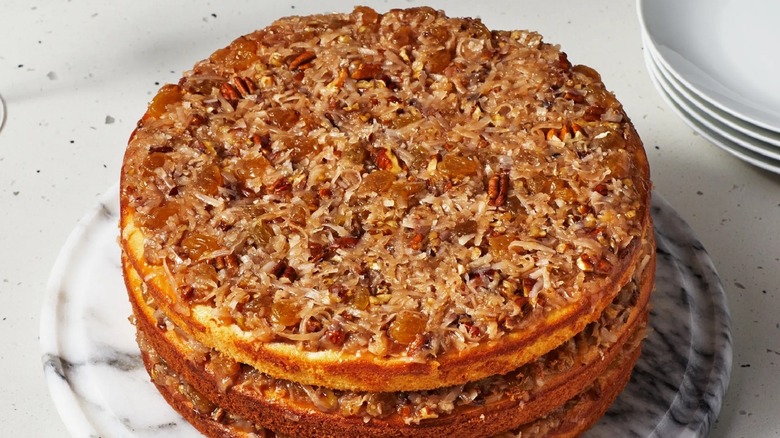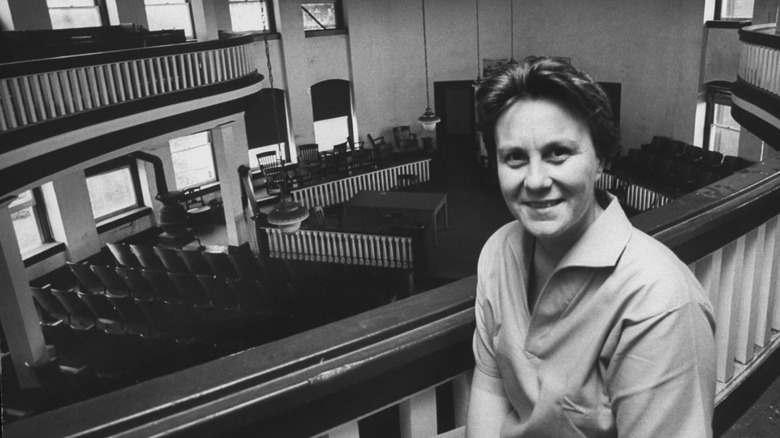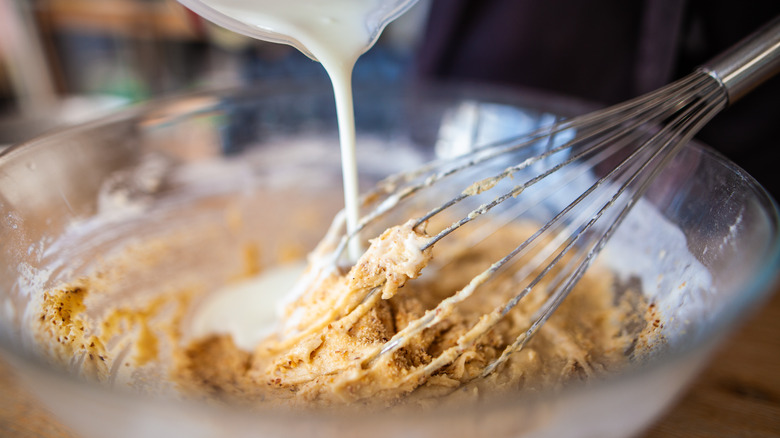How Lane Cakes Became A Classic Alabama Dessert
If you're from the South, you might have heard tales of the dessert, stumbled upon it in a dusty collection of old recipes, or if you were lucky, tasted it yourself. This is Lane cake, the storied, once-common Southern layer cake. Though the towering, elaborate, booze-soaked, custardy creation may not be as popular as it once was, the Lane cake remains a deeply beloved and prized culinary tradition of the South. Nowhere is this more true than in its birthplace of Alabama, where it's still the official state cake.
Much like retro treats along the lines of baked Alaska, lady Baltimore cake, or other nostalgic cakes you probably forgot existed, Lane cakes were once common sights at events and gatherings. The four (or three, depending on who you ask) layer cake, featuring an incredibly rich custard filling of bourbon-soaked raisins and pecans and white icing, is a grand culinary achievement, but it's roots are humble ones. The cake originated at a country fair in the 1890s, where one Emma Rylander Lane of Clayton, Alabama, took home the first place prize for her creation. First referred to simply as "prize cake," Lane eventually renamed her cake to bear her moniker, and the title stuck. She first shared the recipe in her self-published 1898 cookbook, "Some Good Things to Eat," and over the decades, the cake would become a beloved treat in Southern homes for large gatherings, holidays, and other special occasions.
The recipe was republished and even written about in a literary classic
Over the years, the recipe was published and republished in numerous regional and national cookbooks in the 1920s, '40s, and beyond, which only helped keep the cake relevant. And one can't discuss Lane cake without mentioning its presence in the literary classic, "To Kill a Mockingbird." In Alabama-born and-raised Harper Lee's pulitzer-prize winning book, Miss Maudie is famed for her sweet and boozy Lane cakes. The novel's protagonist Scout famously declares, "Miss Maudie Atkinson baked a Lane cake so loaded with shinny it made me tight."
Like with most historic recipes, the original Lane cake shape underwent multiple iterations over the years, with each family tailoring the recipe to their liking. Some made it with more or less whiskey or bourbon (just how much often depended on religious leanings), added coconut, or even loaded the gooey filling with extra goodies like candied pineapple. Some recipes omit the icing altogether – letting the sweet custard take center stage as filling and frosting with others choosing yellow over white cake. Modern reimaginings call for the addition of peaches and peach schnapps – an unconventional play that would have Miss Maudie clutching her pearls, though delicious in its own right.
One thing almost everyone can agree on, is that the cake improves with time and really shines on day two or three, when the bourbon has had ample time to infuse each layer with enough boozy goodness to make anyone a fan.
Though retro, the treat holds up today
Reading about culinary history and treats from bygone eras is one thing, but our preferred way to take a journey through the history books is with a bite of the actual thing itself. And the Lane cake, retro as it may be, holds up. Whether in 1898 when the cake was first put on the map, or today, Southern-born or not, sweets lovers have appreciated the timeless delights of the buttery cake's airy tiers sandwiching layers of gooey, boozy custard filling, enrobed in sugary frosting.
Though the Lane cake has largely fallen from its former glory, you might be lucky enough to find it on the rare bakery or restaurant menu in corners of Alabama and other areas of the deep South. For an experiential stroll through the history books, head to the kitchen and try making one for yourself. Call it an immersive history lesson or a culinary challenge. Call it doing your patriotic foodie duty to help keep a slice of culinary history alive. The payoff will be well worth it.


